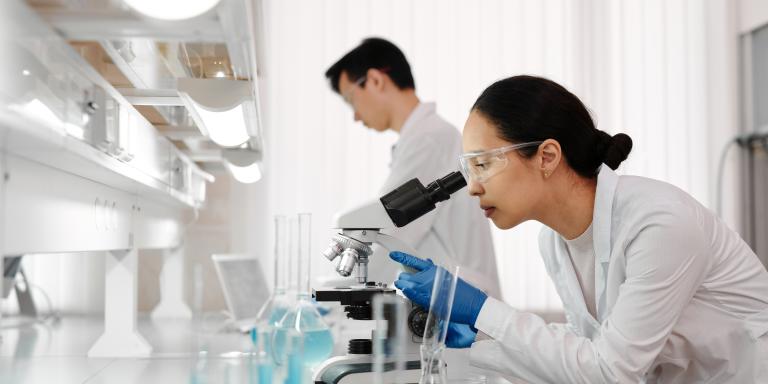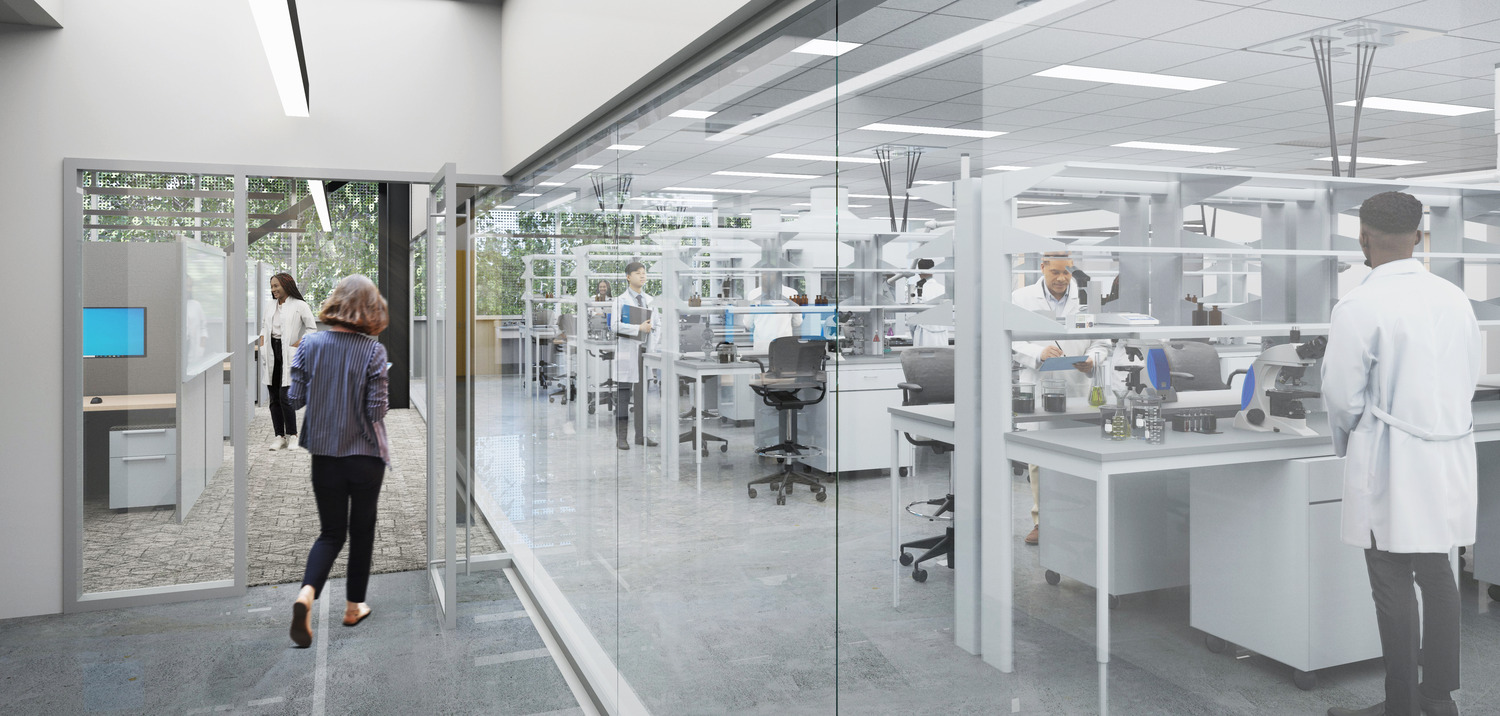
June 30, 2022
Key Takeaways from CREW San Diego: Capturing growth in life sciences real estate market
A new era is emerging in life sciences. Breakthroughs in genomic science are propelling further research and development, which are, in turn, driving science and technology real estate demand.
These users demand a lot from their workspaces. Speakers at a recent CREW San Diego luncheon shared information about how the commercial real estate market can understand and meet those demands. HED's Tracy Morran captured the key takeaways.
Headlining the event were Susie Harborth, executive vice president of business operations for Breakthrough Properties; engineer Nicholas Spath, project manager with Glumac; and architect Matt Brady, a principal with HED.
Takeaway 1:
San Diego is one of the top three markets in the U.S. for life sciences, and Harborth expects it to stay that way. "The fundamentals are very strong, and we're just beginning," she said. "We're in the second inning of the game."
In addition to an already robust industry, San Diego is attracting and growing new industries within life sciences, including agri-technology, said Brady. "This sector of the industry was mostly in North Carolina, but we have a lot of talent that's attracting it," he said.
Takeaway 2:
Even if economic markets soften and some people get out of life science real estate, Harborth said the fundamentals are still there and will continue to attract investors.
"The science is revolutionary," she said. "We're curing cancer. This science will always be funded. It's a very nascent industry, and that will translate into more demand for space."
With recent supply chain difficulties, San Diego may also benefit from pharmaceutical manufacturing that's getting re-shored and from a growing biotechnology products R&D market.
Whether it's a conversion or a new build, the CREW audience was eager to hear from the panel about what these life science users look for when leasing space.
These users demand a lot from their workspaces. Speakers at a recent CREW San Diego luncheon shared information about how the commercial real estate market can understand and meet those demands. HED's Tracy Morran captured the key takeaways.
Headlining the event were Susie Harborth, executive vice president of business operations for Breakthrough Properties; engineer Nicholas Spath, project manager with Glumac; and architect Matt Brady, a principal with HED.
Takeaway 1:
San Diego is one of the top three markets in the U.S. for life sciences, and Harborth expects it to stay that way. "The fundamentals are very strong, and we're just beginning," she said. "We're in the second inning of the game."
In addition to an already robust industry, San Diego is attracting and growing new industries within life sciences, including agri-technology, said Brady. "This sector of the industry was mostly in North Carolina, but we have a lot of talent that's attracting it," he said.
Takeaway 2:
Even if economic markets soften and some people get out of life science real estate, Harborth said the fundamentals are still there and will continue to attract investors.
"The science is revolutionary," she said. "We're curing cancer. This science will always be funded. It's a very nascent industry, and that will translate into more demand for space."
With recent supply chain difficulties, San Diego may also benefit from pharmaceutical manufacturing that's getting re-shored and from a growing biotechnology products R&D market.
Whether it's a conversion or a new build, the CREW audience was eager to hear from the panel about what these life science users look for when leasing space.

Takeaway 3:
Strategic flexibility and sustainability factor large. "Every three years, every life science company has a repositioning of their business because science evolves or they need to reprogram their space between pursuits," said Breakthrough Properties' Harborth. She added that her company typically provides a 60/40 split of lab to office space, but some users need to reverse this split. Flexibility is key.
Science and technology real estate development is cyclical, too, in that scientific innovation drives real estate demand, and design of science and technology projects support new scientific innovation.
Takeaway 4:
In addition to flexibility, a major component in supporting that sustainable life cycle is power.
With groundbreaking science underway, "labs are energy hogs," said Brady, the architect. "I try to make better workflows for the scientists, and minimize equipment and infrastructure duplication."
Whether it's supporting power demands for the scientific work itself or charging electric vehicles in the parking lot, Spath reminded the audience that San Diego's draft climate action plan calls for all new buildings to run on electric energy instead of gas, starting next year. A strong push will be made to decarbonize existing buildings, too.
"Future-proof now so your building isn't outdated in a year," the Glumac executive said, adding that generator capacity is especially important in areas that may lose power due to wildfire danger.
Single-pass air, adequate ceiling heights and wellness certifications are also important to life science tenants, and materials used in a building need to be resistant to fungus growth and easy to clean.
Harborth reported that many tech users are snapping up lab space to benefit from some of these same features, at the same leasing premiums. Conversely, Spath pointed out that "many tech clients are including infrastructure needed for either life science or tech" in order to make their buildings easily convertible in the future.
Takeaway 5:
In response to strong demand for space from life science (and technology), San Diego is seeing a lot of office and warehouse owners converting their buildings to accommodate them. Adaptive reuse is critical from both a demand and an environmental perspective. Building conversions come with risks, though.
"Developers need the conviction and capital to create the necessary infrastructure," said Harborth. "Otherwise, you're an office space. It takes capital — there's nothing cheap about life sciences."
--
These remarks originally appeared in the San Diego Transcript - A link to the original piece is below
Strategic flexibility and sustainability factor large. "Every three years, every life science company has a repositioning of their business because science evolves or they need to reprogram their space between pursuits," said Breakthrough Properties' Harborth. She added that her company typically provides a 60/40 split of lab to office space, but some users need to reverse this split. Flexibility is key.
Science and technology real estate development is cyclical, too, in that scientific innovation drives real estate demand, and design of science and technology projects support new scientific innovation.
Takeaway 4:
In addition to flexibility, a major component in supporting that sustainable life cycle is power.
With groundbreaking science underway, "labs are energy hogs," said Brady, the architect. "I try to make better workflows for the scientists, and minimize equipment and infrastructure duplication."
Whether it's supporting power demands for the scientific work itself or charging electric vehicles in the parking lot, Spath reminded the audience that San Diego's draft climate action plan calls for all new buildings to run on electric energy instead of gas, starting next year. A strong push will be made to decarbonize existing buildings, too.
"Future-proof now so your building isn't outdated in a year," the Glumac executive said, adding that generator capacity is especially important in areas that may lose power due to wildfire danger.
Single-pass air, adequate ceiling heights and wellness certifications are also important to life science tenants, and materials used in a building need to be resistant to fungus growth and easy to clean.
Harborth reported that many tech users are snapping up lab space to benefit from some of these same features, at the same leasing premiums. Conversely, Spath pointed out that "many tech clients are including infrastructure needed for either life science or tech" in order to make their buildings easily convertible in the future.
Takeaway 5:
In response to strong demand for space from life science (and technology), San Diego is seeing a lot of office and warehouse owners converting their buildings to accommodate them. Adaptive reuse is critical from both a demand and an environmental perspective. Building conversions come with risks, though.
"Developers need the conviction and capital to create the necessary infrastructure," said Harborth. "Otherwise, you're an office space. It takes capital — there's nothing cheap about life sciences."
--
These remarks originally appeared in the San Diego Transcript - A link to the original piece is below